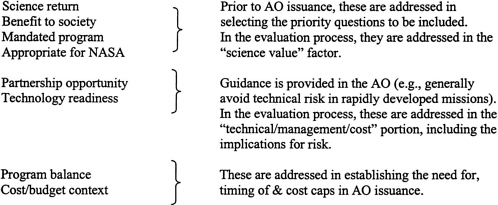APPENDIX C
NASA Document: “Applying Science and Implementation Priorities to Candidate Exploratory Mission Concepts”46
In the context of describing how the Earth Science Enterprise will implement the observational portion of its Research Strategy, we are working to define approaches for identifying exploratory, systematic, and technology demonstration/ operational precursor satellite missions. The following defines an approach for exploratory mission concepts. Exploratory missions are generally small, rapidly developed missions focused on understanding high priority Earth System processes that are least understood or where the current state of our understanding is very limited of the controlling forces acting on the Earth System, and the Earth's response to such forcings.
Science and implementation priority criteria in the ESE Research Strategy are listed below, with a description of how they would be addressed in an Exploratory Announcement of Opportunity (AO):

-
Formal proposal Evaluation Criteria include: (1) Science Value, (2) Technical Approach, (3) Commercial Development Opportunities, and (4) Education and Public Outreach. Science Value is determined by integrating the assessments of both Scientific Return and Cost to NASA, each of which is described below. Commercial Development Opportunities may include proposer contributions to the overall cost of the effort, i.e., cost sharing, and will be considered as part of the NASA Cost evaluation.
-
The Technical (including management) and cost criteria are measures of implementation risk and NASA will assign risk ratings. For these criteria a factor can outweigh all others if it jeopardizes overall mission success.
-
Science Value will be assigned a higher value than any other factor. For traditional mission developments, Technical Approach is the next highest weighted factor, followed by Commercial Development opportunity and Education & Public Outreach. For commercial data purchase arrangements, Commercial Development Opportunity is the second highest weighted factor, followed closely by Technical Approach, then by Education & Public Outreach.
|
46 |
NOTE: The material reprinted in this appendix was supplied by NASA on May 18, 2000. |
Application of these principles in development of an actual Announcement of Opportunity will proceed according to standard procurement practices, including the posting of a draft AO for an open comment period. Other classes of missions will employ an analogous approach to applying science and implementation priority criteria.


